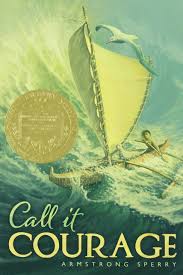Armstrong Sperry’s Call it Courage
Listen to the Recess! Clip
| Author | Rita Smith |
| Air Date | 11/4/2004 |

Armstrong Sperry’s Call it Courage Transcript
When Armstrong Sperry was a boy in Connecticut, he had a grandfather who had been to sea. The grandfather told young Armstrong hair-raising tales about his adventures in the far corners of the world including being shipwrecked on the South Sea island of Bora Bora. “It was the purtiest little island I ever did see,” he told his grandson, “I hope you’ll see it for yourself someday.”1 Armstrong held the dream of finding that island through elementary and high school, and through Yale University where he studied art and became an illustrator.
He got the opportunity in to visit the South Seas in 1925 when he joined an expedition as an assistant ethnologist for the Bishop Museum of Honolulu and lived on Bora Bora for a year, as a guest of the chief. When he first saw the island it appeared so fresh and beautiful that it seemed “as if it had just risen up from the floor of the sea that morning.2 His childhood dream of finding Bora Bora had come to life. During his stay there, the people of the island experienced a devastating hurricane, and their courage and resiliency inspired Armstrong later when he returned to the United States.
It was eight years after his stay on the island that he decided to write a children’s book set in Polynesia. It was to be a simple story about one day in the life of a boy who lived on a South Pacific Island. All his training had been in illustrating and drawing so he planned to tell the story entirely in pictures. He made over forty pictures and then decided to give each one a caption. “The captions grew longer and longer,” he wrote, “and the first thing I knew, I was writing a book.” The book was such a success that he wrote several more books about a child’s typical day in various geographical settings. But the same formula repeated in book after book didn’t appeal to him very much, he branched out and wrote a book that was a biography of a ship, the Flying Cloud, told through the eyes of a young apprentice who helped build the ship and sailed on her maiden voyage.
Armstrong wrote eleven books for children, including Call It Courage, which won the Newbery Award in 1941. His characters make mistakes and have fears, but they have the courage to work through the mistake and overcome the fear.
Many of the stories are set in the South Sea islands and most of them are filled with action. That is one thing Sperry learned about writing for children. “Every word,” he says, “must tell.” The writer who loses himself in the windy descriptive passages, who indulges too many flights of philosophical fancy, will wake up to find that his reader had gone out to play ball.”4 His stories sailed along and children responded to them with just as much awe and enjoyment as he had responded to those yarns of pirates and shipwrecks his grandfather told him many years earlier.
Notes
1Kunitz, Stanley J. and Howard Haycraft. “Armstrong Sperry” in The Junior Book of Authors, 2nd ed. New York: H.W. Wilson Company, 1952, p. 278-280.
2Sperry, Armstrong. “Newbery Award Acceptance Paper” delivered in Harvard Yard, Cambridge, MA June 20, 1941. Available on the web at http://www.ogram.org/sperry/papers//NewberyAcceptance.shtml.
3Sperry, Armstrong. “On Writing for Young People” 1959, unpublished manuscript, available on the web athttp://www.ogram.org/sperry/papers/OnWriting.shtml.
4Ibid.
Sources
“Armstrong Sperry Home Page”: http://www.ogram.org/sperry/papers/OnWriting.shtml .Updated and maintained by Margo Burns